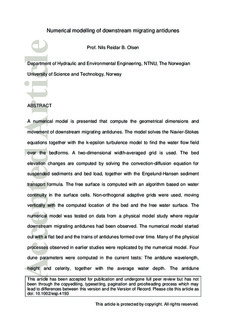Numerical modelling of downstream-migrating antidunes
Journal article, Peer reviewed
Accepted version
Permanent lenke
http://hdl.handle.net/11250/2470910Utgivelsesdato
2017Metadata
Vis full innførselSamlinger
Sammendrag
A numerical model is presented that compute the geometrical dimensions and movement of downstream migrating antidunes. The model solves the Navier–Stokes equations together with the k-epsilon turbulence model to find the water flow field over the bedforms. A two-dimensional width-averaged grid is used. The bed elevation changes are computed by solving the convection–diffusion equation for suspended sediments and bedload, together with the Engelund–Hansen sediment transport formula. The free surface is computed with an algorithm based on water continuity in the surface cells. Non-orthogonal adaptive grids were used, moving vertically with the computed location of the bed and the free water surface. The numerical model was tested on data from a physical model study where regular downstream migrating antidunes had been observed. The numerical model started out with a flat bed and the trains of antidunes formed over time. Many of the physical processes observed in earlier studies were replicated by the numerical model. Four dune parameters were computed in the current tests: The antidune wavelength, height and celerity, together with the average water depth. The antidune wavelengths were best predicted with an accuracy of 3 to 8% compared with the measurements. The antidune heights were computed with a deviation of 11 to 25% compared with an empirical formula. The water depths over the antidunes were predicted with an accuracy of 3 to 9% related to the measured values. The average antidune celerity was the parameter with largest deviation: For the coarsest grid it was overpredicted with 37%.
